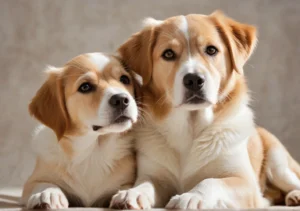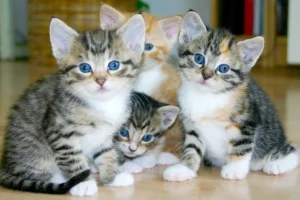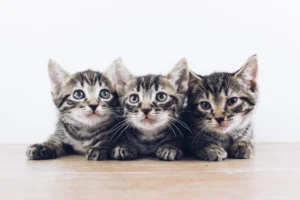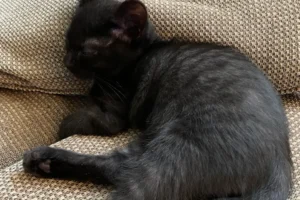Cats have long been fascinating creatures that have captured the hearts of many. One particular term associated with cats that piques curiosity is why they are called tabby. In this blog post, we will unravel the mystery behind the naming of these beloved furry friends.
Origins of the Term ‘Tabby’
So, why exactly are cats called tabby? Well, let’s take a journey back in time to unravel the mystery. The term ‘tabby’ actually has its roots in the Arabic word ‘attābī’, which refers to silk cloth with rippled water-like patterns, much like the unique markings found on tabby cats.
As trade routes expanded and cultures intertwined, the term made its way to Europe, where it eventually became associated with cats sporting the characteristic striped or swirling patterns we now recognize as tabby markings. This historical connection gives tabby cats a touch of exotic allure that sets them apart from other feline friends.
Characteristics of Tabby Cats
What makes tabby cats so distinct? Well, these charming felines are known for their striking coat patterns that can range from classic stripes to elegant swirls and even intricate mosaics. One interesting feature of tabby cats is the ‘M’ shape often visible on their foreheads, a unique quirk that adds to their charisma.
But it’s not just about looks – tabby cats also have playful and affectionate personalities that make them beloved companions. Their inquisitive nature and social demeanor ensure that they quickly become the center of attention in any household.
- Tabby cats come in various colors, including gray, orange, and brown, each with its own distinctive charm.
So, the next time you admire a tabby cat’s unique markings and engaging personality, remember the rich history and captivating characteristics that make them truly special.
Tabby Cat Breeds
Tabby cats are not a specific breed but rather a coat pattern found in many cat breeds. Some cat breeds commonly exhibiting tabby markings include the American Shorthair, Maine Coon, and Scottish Fold. Each breed may have its unique twist on the classic tabby pattern, whether it’s swirls, stripes, or spots. Regardless of the breed, tabby cats are known for their playful personalities and charming demeanor. So, if you’re looking for a feline friend with a striking coat and a lovable character, a tabby cat might be the perfect match for you.
Symbolism of Tabby Cats
Tabby cats have been symbolic in various cultures and societies throughout history. In ancient Egypt, tabby cats were revered for their connection to the goddess Bastet, who was often depicted as a lioness or a woman with a lioness head. This association with a divine feline tied tabby cats to protection, fertility, and grace. In Celtic folklore, tabby cats were believed to bring good luck and were thought to have the ability to see into the spirit world. Even today, tabby cats are considered to be symbols of independence, curiosity, and adaptability. So, if you have a tabby cat at home, know that you have a special and meaningful companion by your side.
Tabby Cat Personalities
Tabby cats are known for their unique personalities that endear them to their human companions. These feline friends are often described as affectionate, playful, and curious. They enjoy interacting with their owners and love to explore their surroundings. Tabby cats are also known for their independent nature, but they can be quite social and enjoy spending time with their family members.
One interesting trait of tabby cats is their vocal nature – they are not shy about expressing themselves with a variety of meows, purrs, and chirps. This can make them great communicators and add to their charm. Additionally, tabby cats are known for their intelligence and problem-solving skills, making them engaging and fun pets to have around the house.
Tabby Cat Personalities:
- Affectionate and playful
- Curious and explorative
- Independent yet social
- Vocal communicators
- Intelligent and good problem solvers
Tabby Cat Genetics
The distinctive markings that make tabby cats so recognizable are a result of complex genetics. These unique patterns are inherited through generations, with certain genes dictating the specific stripes, swirls, or spots that adorn a cat’s coat. The ‘tabby’ term itself is believed to have originated from the French word ‘tabis,’ referring to a silk fabric with a striped pattern – quite fitting for these beautifully patterned felines.
One fascinating aspect of tabby cat genetics is the role of the ‘agouti gene,’ which determines the distribution of colors in a cat’s fur. This gene is responsible for creating the distinctive tabby patterns that are so beloved by cat enthusiasts worldwide. Understanding the genetics behind tabby cats can offer insights into the fascinating world of feline inheritance and help explain the diversity of markings seen in these charming creatures.
Why Are Cats Called Tabby?
Have you ever wondered why cats are called tabby? The term “tabby” actually comes from a word in Arabic, “attaabi,” which means silk or watered silk. This is because tabby cats have a coat pattern that resembles the wavy lines found in silk fabric. Interestingly, tabby is not a specific breed of cat but rather a pattern that can be found in various cat breeds.
Fun Facts about Tabby Cats
- Tabby Coat Variations: Did you know that there are four main tabby coat patterns? These include classic, mackerel, ticked, and spotted tabby patterns.
- Tabby Genetics: The tabby coat pattern is actually a result of a specific gene called the agouti gene, which determines the banding and coloration of the hair in cats.
- Historical Significance: Tabby cats were highly regarded in ancient Egypt, believed to bring good luck and protection. They were even associated with the goddess Bastet, who was often depicted as a cat.
Tabby Cat Care Tips
Are you a proud owner of a tabby cat? Here are some essential care tips to ensure your furry friend stays healthy and happy:
- Regular Grooming: Tabby cats may shed more than other breeds, so regular grooming is essential to prevent matting and hairballs.
- Proper Nutrition: Make sure to feed your tabby cat a balanced diet that meets their nutritional needs. Consult with your veterinarian for recommendations on the best food options.
- Regular Vet Visits: Schedule routine check-ups with your vet to ensure your tabby cat is in good health and up to date on vaccinations.
- Playtime and Enrichment: Keep your tabby cat mentally and physically stimulated with interactive toys and play sessions. This helps prevent boredom and encourages exercise.
- Safe Environment: Create a safe environment for your tabby cat by removing any potential hazards and providing a comfortable and cozy space for them to rest and relax.
Remember, providing proper care and attention to your tabby cat will help strengthen the bond between you and ensure a happy and healthy life for your feline companion.
Alex, a passionate animal lover, has experience in training and understanding animal behavior. As a proud pet parent to two dogs and three cats, he founded AnimalReport.net to share insights from animal experts and expand his knowledge of the animal kingdom.




